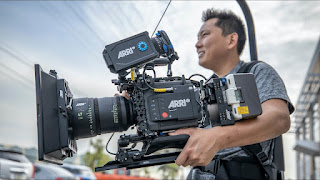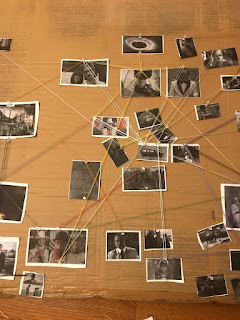Critical Reflection
In my short film, my group represented the lgbt community by portraying a lesbian couple instead of the usual straight couple. The goal was to shine light and normalize same-sex couples in film. While neither of us are part of the lgbt community, we hoped to shine light on this issue and continue to normalize same-sex couples in film. Neither Aja nor I can fully understand the struggles of same-sex representation in the media or film, we can sympathize and try our best to make a change. My group did our research on the complexities of lgbt relationships in order to feel prepared to represent one ourselves. When we decided on what the dynamic would be, between the two of us, Aja and I decided that our characters would behave in a stereotypical man/woman role. Instead, we decided to leave that out entirely, finding the best results in us being ourselves, no typical “who wears the pants” dynamic. In addition to that, the cast in the short film was very diverse. While I am European, my co-star, Aja is middle eastern and our film manger Jordyn, is Bulgarian. Because out our diverse cast and crew, we were able to embody not only a same-sex couple, but also a one of multiple races and cultures. This is also not completely normalized, but surely beginning to become more represented. In hopes of full normality of these issues, we aspire to be part of the solution for underrepresented minorities and same-sex couples in film, as well as other forms of media. Another way my short film represents social issues is the main idea that out main character, played by me, is a semi-functioning alcoholic. My character is portrayed to be so deep in an addiction to alcohol, that she consistently loses her memory every 24 hours as a result of Wernike-Korsakoffe Syndrome. This is a real issue in many people and is caused by excessive drinking. The goal was to shed light on this disease in women, because it is much more common in men. In doing this, more people will be knowledgeable about its effects in women and hopefully gain awareness to the rare condition. Adding to this, as people with partners suffering from an alcohol addiction commonly do, the short film shows the signs of abuse and consequences of the abuse happening. The result, in this case, is the death of the innocent partner. In implementing this factor in our film, our purpose was to spread awareness and advocate for those in a similar situation. These issues are all prevalent social issues that deserve the attention that my co-stars and I are trying to achieve for them.
The main element in the short film is my character’s alcoholism led Wernike-Korsakoffe Syndrome that resets her memory every 24 hours. In order to create a sense of branding, we led with the alcoholism and the number 24 as a main theme for almost all of out branding. For the advertisement element, the number 24 on an alarm clock was the thing associated with this film, that being the name of the film is “24” in order to advertise our film, we created social media accounts with name official24_film, again including the number 24. We also made postcards and a website with the main theme of alcohol and the number 24. The postcard was decorated with various bottles of alcohol on the front side and had an image of an alarm clock on the back, with the time set at 00:24. The usage of the time 00:24 is used to make sure people think of the film every time they see an alarm clock or the number 24. The branding is all relevant to out theme of alcoholism and alarm clocks, which keeps people from confusing my film with other films. In the film’s website, the consistent theme of alcoholism and alarm clocks is used again. Also part of advertising, the social media accounts connected to this film are used to create a sense that the viewers can get to know the actors. In this, we posted pictures of each actor on set, and created a “get to know the character” passage, where a viewer could read more background on each character if they wanted. In addition to advertisement, the material in the film is also very centered to the main theme. Any text in the film was put in an “alarm clock” looking font. This also helped viewers to associate alarm clocks to our brand. The alarm clock seen in the very first scene is also set to 00:24, the name of the film. This was a clever idea of our editor, Jordyn, to include the film name into the opening scene, furthering our branding to any viewer. The consistency within the film’s branding is useful when it comes to advertising and viewer association. This is in a similar way to when you see a cruise ship, many people think of the popular film “Titanic”. The advertisement team from Titanic was very consistent and relentless when it came to marketing the film to the brand of a cruise ship. This is the approach that my marketing team had. Using object association in film is very common and effective when it comes to marketing effectively. No matter the outcome, my team will most likely always think of out film when we see the number 24 or alcohol. This is proof that this marketing tactic works effectively.
Our products, like the social media accounts, postcards, and website, engage with the audience by offering real life updates on the filming process, and provide the ability to ask questions about the film and the characters. Our postcard is a tangible was to advertise and create a fun decoration while also advertising the film. By sending the postcards out to people, we can create a sense of community within the short film’s fanbase. The Instagram account is a way for fans to learn more about the individual characters life and background, as well as the actor who plays them. This aspect of the social media account helps to make the cast feel personable and real, like you are friends, not some big time ‘better than you’ actor. The Tik Tok account created was used for behind-the-scenes footage to show that the crew has personality and is likable, all helping to engage with the audience.
My research of lgbt relationships and WKS helped to inform me of the way that they challenge conventions. For example, I learned how underrepresented lesbian relationships are in film. I also learned how implementing this in the film would help advocate and bring awareness to the issue, eventually helping it become a more common convention in film. Another convention I challenged is alcoholism (WKS) in women. The issue of alcoholism in women is vaguely shown, and if it is, it is romanticized, or the woman is saved by a man. By not implementing a happy ending and villainizing alcoholism in women, I challenge the convention of “hero men” and “damsel in destress”. My research brought to light the fact that women are very rarely shown as the villain, but filmmakers rather use the convention that men should save women, and that a man will fix a woman, neither of which happen in my film “24”.


Comments
Post a Comment